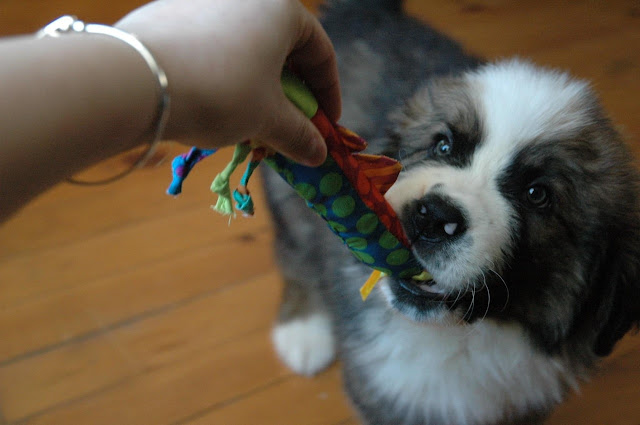Gentle Giant: Saint Bernard was once a hospice dog but is now a giant companion
 |
| Photo by Pipistrula Foter.com CC BY NC SA |
The gentle and quiet Saint Bernard may not have had an
official name until the 1880s, but it's now one of the most popular giant dog
breeds. The Saint's droopy face has drooled its way into the hearts of pet owners worldwide.
Saint Bernard is the dog definition of a gentle giant.
On average this decedent of the Mastiff weighs 110 pounds- but both males and
females have been known to weigh in at 200 pounds. Hazel's mother, a purebred Saint Bernard names Noisette, which means Hazelnut in French weighed around 150lbs. This gigantic pet belongs to
the working group of dogs and like its Bernese Mountain Dog neighbor, it was used for draft work in the past. Saint Bernard is most known for
its work as a search and rescue dog. It has a sacred past- which is how the
breed finally got its official name in 1880.
Although the breed’s history is not well documented, it's
likely the Saint Bernard originated sometime between 1660 and 1670 when
monks bred together a Tibetan Mastiff, Greater Swiss Mountain Dog, a Great
Pyrenees, and a Great Dane. The monks that bred these sacred dogs lived in the
Hospice du Grand Saint Bernard in Switzerland. They used the dogs as draft
dogs to pull carts, watchdogs, and companions at first. At the beginning of the 1700s, the
dogs were accompanying monks during search and rescue missions in harsh
mountain weather.
 |
| Photo by ATIS547 Foter.com CC BY NC SA |
The Saint Bernard became known for its skills as a
pathfinder in the snow and for predicting avalanches due to its ability to hear
low-frequency sounds we humans cannot. The dog would track lost travelers
in the frigid mountain-top snow with its remarkable sense of smell. The
breed can actually smell a person under the snow. When the dog would sniff out a person
buried in an avalanche it would lick the person's face to revive them. The dog
would then lay next to the buried traveler to provide warmth and wait for searching monks to find them.
The breed has been a search and rescue dog for over 300
years and has been credited to saving as many as 200 lives. Up until the 1880s, the Saint Bernard was commonly referred to as 'Hospice Dog' but had many
names which include Monastery Dogs, Swiss Alpine Dogs, Sacred Dogs, and Mountain
Dogs. Aptly named after the hospice the dog originated from, the Saint
Bernard’s history as a life-saving canine has made it famous.
I hate to disappoint you, but the Saint Bernard with the barrel of brandy around its neck is a myth. Seventeen year-old English artist Edwin Landseer painted Alpine Mastiffs Reanimating a Distressed Traveler depicting a Saint with a barrel on its collar. Considered a prodigy because he could paint with both hands simultaneously, Landseer was likely unaware that his artwork would spawn a myth that would stand the test of time. While Saint Bernards did rescue travelers, they did not carry barrels of brandy the share with them.
The most famous of all Saint Bernards was Barryder
Menschenretter. This hospice dog saved over 40 lives prior to its death and as
a tribute to the dog, the breed was long referred to as Barryhund. When the name was finally agreed upon it paid tribute to both the hospice and
the legendary Barry.
 |
| Photo by hfb Foter.com CC BY ND |
In 1830 after many Saint Bernard’s died from disease,
inbreeding and harsh winter weather, a large number of Saint Bernard’s were bred
with Newfoundland dogs in an effort to create a warmer, longer coat. But the
snow and ice stuck to the long-coated dogs and they were unable to work as
search and rescue dogs.
Later, the dog exported to England, and not long after the Saint Bernard was exported to America. The Saint Bernard
was recognized by the American Kennel Club in 1885. The breed’s popularity in
America rose thanks to the Beethoven movies and positive
testimonials from Saint Bernard owners. Luckily, the Beethoven films are combating the Cujo perception of the breed. Thanks a lot, Stephen King! Today the breed remains one of the most
popular giant breeds in America and a renowned family dog.
The Saint Bernard is still bred with short and long coats. They are tri-color but mostly brown, with brown tones ranging
from dark to light tan, a white chest and socks, and black accents on most of the face. Ears are medium length, floppy, and are usually brown or black.
Saint Bernard’s face is droopy. The dog’s eyes droop
creating an inquisitive expression. Due
to the droopy jowls, the Saint Bernard drools a lot. Potential owners of the breed
should keep this in mind before adopting- you are not likely to find a Saint
Bernard that doesn't drool...sorry.
 |
| Photo by ro0ter Foter.com CC BY NC SA |
The giant dog has a massive head and can be quite tall. When
showing this breed competitively the taller the better, as tall Saint Bernard’s
are very prized. Because of the sheer size of the breed, it's important to
teach it not to jump up on people as a puppy. The gentle
and calm nature of the breed means it can do well in apartment settings, despite its
size. In order to live comfortably in an apartment, it needs physical
activity, mental stimulation, affection, and discipline with its family.
Saint Bernard is an extremely friendly and gentle breed.
These dogs are loyal and eager to please. They are highly trainable and very
smart, so start training early. The Saint Bernard can learn advanced tricks and
is calm and submissive during training. Saint Bernard’s are generally very
quiet and rarely bark unless they deem it absolutely necessary.
These dogs are very patient and tolerant of children and
other pets. They move slowly with precision but are more agile than they
appear. Saint Bernard is not often playful with people or other pets. They
make great watchdogs due to their size and loud, deep bark. These qualities
make the Saint Bernard a fantastic pet to have in a family of young children.
Not to mention it has a history of predicting avalanches and impending danger!
The Saint Bernard is known to have a stubborn streak- if
this dog doesn't want to do something it’s not going to. Just ask Hazel! They can be sensitive
at times, so while training it may be best to use a lot of positive
reinforcement while still asserting dominance.
Saint Bernard needs moderate exercise and should have
one long walk a day. Keep other walks brief. Owners of this breed should make sure the dog
doesn't get bored. The Saint Bernard is smart and can fetch and retrieve a
ball, play with a treat ball, or solve a doggie puzzle. Hazel loves puzzles! But she can't fetch to save her life... Maybe she would fetch to save another's life?
 |
| Photo by murilocardoso Foter.com CC BY NC SA |
Puppies of this breed should not have too much exercise
until their bones are well-formed, due to the rapid growth rate of the breed.
It's recommended a Saint Bernard puppy only take brief walks and have
short play sessions until approximately two years of age. The breed does the
majority of its growth in the first two years of life. 100 different Saint
Bernard puppies were used to make the movie Beethoven’s 2nd due to how quickly
the breed matures.
The Saint Bernard has an average life span of 8 to 10 years.
Major health concerns for this breed can include hip dysplasia, elbow dysplasia,
gastric ailments, entropion (the eyelids turn in towards the eyeball), and
ectropion (a slack eyelid edge that turns outward.) Other health concerns can include
diabetes, seizures, hot spots, cardiomyopathy, and other heart conditions.
Suggested veterinary tests include hip, elbow, eyes, and heart. These dogs are
prone to bloat so a few small meals a day is important, as is exercising before
meals and avoiding heavy physical activity right after a meal. That being said, it is important Saint Bernard owners take extra care in making sure the
dog does not become overweight. This breed does not tolerate the heat well so
monitor for heatstroke in the summer.
Whether this breed is pulling a cart, rescuing lost
travelers or interacting with children, the Saint Bernard is a fantastic choice
for any dog lover. The breed’s popularity continues to rise. Just like
finding a lost soul in the snow, the Saint Bernard has found its way into the
hearts of families across the world.
Give me a high paw and follow Paws For Reaction on Pinterest
Like Paws for Reaction on Facebook
Follow @PawsForReaction on Twitter
Follow my blog and subscribe in the sidebar >>
Like Paws for Reaction on Facebook
Follow @PawsForReaction on Twitter
Follow my blog and subscribe in the sidebar >>
avalanche
breed profile
calm
children
dog breed
dog breed profile
gentle
giant
giant breed
health
history
hospice dog
monks
religion
rescue
sacred
Saint Bernard
St. Bernard
temperament
winter





















0 Comentarios